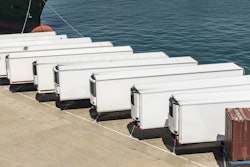It can be difficult to pass up a trailer full of brake components that are offered at a bargain-basement price. Cost-conscious customers may be more than willing to try some unknown friction material for trailers of their own, or even save a few dollars by spec’ing unfamiliar wiring.
In the end, however, there is always a price to be paid – and it can emerge in the form of limited service life and longer stopping distances.
Those who supply premium aftermarket brakes point to a lack of standards as one of the problems, noting how original equipment on a new trailer must conform to the federally regulated rules of FMVSS 121, while an aftermarket lining can be made from a variety of materials with dramatic differences in quality and performance. For instance, a simple FF (lining edge code) pad can be made from 20 different materials, and each of them will offer different performance characteristics, says Jim Vigliano, ArvinMeritor’s director, fleet sales.
Today’s comparisons are largely limited to the independent ratings posted by the Society of Automotive Engineers’ Performance Review Institute (www.pri-network.org), which measure the torque delivered by 40-psi brake applications.
“It attempts to give you some indication of how they stack up,” says Randy Petresh, Haldex’s vice-president of technical support. The Technology & Maintenance Council of the American Trucking Associations only now is considering whether the tests should expand beyond common 16.5 x 7-inch material, and include details about factors such as a manufacturer’s quality certificates, the presence of asbestos and the country in which the linings are made.
Counterfeit offerings have emerged among other brake components as well. Haldex, for example, has identified numerous copies of its automatic slack adjusters. Bendix has seen copies of valves that are packaged to look like the genuine articles.
Appearances can be more than just deceiving, and the quality of the product must be considered. Thinner valve walls can lead to cracks or ruptures. Inconsistent tension in the springs can turn a valve into little more than an on-off switch, eliminating any hope of a gentle brake application. Stiff O-rings quickly will lead to air leaks.
Even brake chambers are being copied in today’s market, says Paul Waszkowski, Bendix sales manager, trailer products. He finds the sealing practices of lesser-quality chambers to be particularly troublesome. Traditional designs are crimped or welded shut, but cheaper options are simply clamped together. A technician who tries to unbolt such a chamber could be injured by the explosive force of the spring inside.
“It’s significantly cheaper,” he says of the drawing power of these chambers, “and it’s found its way into the container chassis market.”
Some fleets also are choosing to replace a single chamber at a time, rather than ensuring a common brand across the entire axle, Waszkowski says. Even though the different chambers offer acceptable outputs between 20 and 30 psi, lower or higher pressures can lead to wide variations in stopping forces.
“All of this adds up to the trailer brakes wearing out before they should.”
Equally, fleets should be replacing hardware whenever they exchange brake shoes, says Vigliano, noting how this practice is particularly important in an era of asbestos-free friction formulas. The damaging heat from each brake application can easily spread through a modern brake shoe to the springs, rollers and clips. Shops should also be encouraged to replace any cam bushings that are out by more than .030-inches in any direction, since that movement could affect the ultimate brake stroke, he adds.
AIR AND ELECTRICAL
Of course, any brake application also will require a steady supply of air, and that leads Gates Product Manager Everett Bowen to stress the importance of well-matched air lines and couplings. A 3⁄8-inch hose rated at 1000 psi will only be as strong as its 500-psi coupling. Manufacturers also will differ in their choice of allowing tolerances at the high or low end of any measurements, and that could sacrifice a tight fit when brands are mixed, he says.
Even the selection of brake line antifreeze can make a difference in the life of trailer brakes, says Hank Schneider, regional manager for Sealco Commercial Vehicle Products. Anything other than a formula made specifically for this purpose will degrade the grease and O-rings, eventually causing valve pistons to stick.
The challenges of inferior parts are not limited to friction and air, either. The supply of electricity between the tractor and trailer will affect everything from the illumination of a taillight to ABS performance.
It is one of the reasons that trucks are sold with the lime green J560 cables that include four 12-gauge wires, a pair of 10-gauge wires and an 8-gauge ground. Ironically, the biggest-selling cable in the aftermarket is a traditional black cable that includes six 14-gauge wires and a 12-gauge ground, says Travis Hopkey, director of marketing for Phillips Industries.
Even the length of the cable can make a difference if a fleet tries to save a few dollars by choosing a 12-foot design to replace a 15-foot cable, he says. If the connections are on the driver’s side of the tractor and trailer, a 12-foot cable might pull out of its socket when the vehicle makes a sharp right turn.
One of the most common electrical problems involves the corrosion of the wires that feed through the trailer itself, and it’s becoming a bigger challenge as states coat more roads with magnesium chlorides and calcium chlorides. These de-icing agents come in the form of a fine mist that will find its way into every crack and crevice, and will stay wet down to a humidity of 15 percent – giving it plenty of time to adhere to exposed terminals and wires, Hopkey says.
“Any connection that has to be made, any repair, needs to be sealed up with heat-shrink terminals and shrink tubing,” he says. “Most people know about nylon or PVC butt connectors, but you never should use those. That’s a recipe for downtime.”
A vinyl butt connector can pull apart with 57 pounds of force, while nylon will come apart at 70 pounds. In contrast, a crimp-and-seal connector with heat shrink will withstand 100 pound of force.
If you purchase supplies of shrink tubing be careful to ask about the amount it will shrink. Some will shrink more than 10 percent, compared to higher-quality products that will shrink a mere one or two percent.
Harnesses also should come from a reputable manufacturer and be sealed properly to ensure that connections remain tight, Hopkey says. “Even today, they’re still using junction boxes and bringing all the connections into one junction box at the middle of the trailer, filling it with grease and shutting the lid.
“Make sure that the cables and the wiring they are replacing are able to handle the load,” he continues. “You need to know what environment it’s going to be in, its capacity and whatever the amp draw is. Voltage is only as good as the piping through the entire harness.”
Waszkowski puts the need to market quality brake products another way: “You’re talking about brakes. You’re talking about safety.”
It’s difficult to put a price on that.
–John G. Smith







